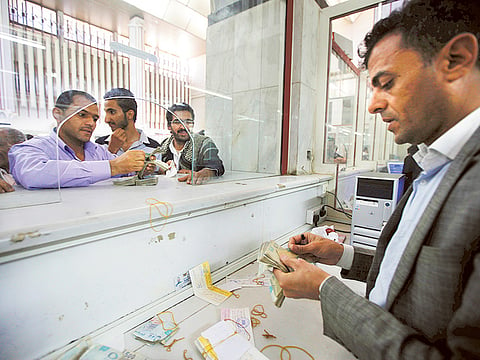Currency rout pushes Yemen to brink of starvation
The economy shrank 28% in 2015 and was set to contract further in 2016, according to the latest World Bank data

Dubai, Cairo: Anwar Abdullah goes to work every day but he hasn’t been paid in five months. When prices for wheat, sugar and other staple foods spiked earlier this month, the Yemeni school teacher feared for his three children.
A civil war that flared into a regional conflict has devastated Yemen’s economy and pushed millions to the brink of starvation. The local currency’s depreciation and the bombing of ports and roads have disrupted the distribution of food imports on which the poorest Arab country depends. Two of every three of the nation’s 27 million citizens struggle to get enough food to survive, according to the United Nations.
“The situation is deteriorating rapidly because of the conflict,” Reem Nada, a spokeswoman for the UN’s World Food Programme, said by phone from Cairo. “The current level of hunger in Yemen is unprecedented.”
Wholesale prices for wheat in Taiz, a city besieged by Iran-backed Al Houthi militants, surged by more than 40 per cent on February 12, when the black-market value of Yemen’s currency, the riyal, plunged 30 per cent against the US dollar. The latest price spike suggests that food imports, which provide for 90 per cent of the country’s needs, could become even harder for people to afford.
“What can we do? We have nothing,” Abdullah, 38 years old, said on February 14 from the capital Sana’a. “With the new price hikes, we will go begging in the streets.”
Yemen was already unstable before the outbreak of civil war in March 2015 plunged it into chaos, allowing Al Qaida to thrive.
Al Houthi militia drove President Abd Rabbo Mansour Hadi’s government from Sana’a to the southern port of Aden. Saudi Arabia and Arab allies then entered the war to restore Hadi’s internationally-recognised government.
The economy shrank by 28 per cent in 2015, as Yemen’s already modest output of oil tumbled, and was set to contract further in 2016, according to the latest available data from the World Bank.
“We are looking at a serious risk of starvation for a large proportion of the population,” Sherin Varkey, Unicef’s acting representative for Yemen, said by phone from Sana’a.
The riyal slumped to 390 to the dollar on the black market on February 12, after trading at about 300 for several months, money changers in Sana’a, Aden and the city of Taiz said by phone. As a result, a 50-kg sack of wheat, which many Yemenis buy to make bread, jumped 42 per cent that day to 8,500 riyals, while the price for the same amount of sugar rose 27 per cent, according to Ahmad Al Sharabi, a food wholesaler in Taiz.
“The riyal is very much overvalued and the government isn’t in a position to defend it,” Peter Salisbury, a senior research fellow at Chatham House, said by phone from London. “If the riyal devalues, it worsens the hunger crisis in the country.”
The riyal returned to 300 per dollar on the black market on February 14, as both the Hadi government and Al Houthis imposed controls on money changers. It has fluctuated to as much as 330 to the dollar since then, Taha Ahmad, a Taiz-based money changer, said by phone.
Four of Yemen’s 21 provinces — Abyan, Hadhramaut, Taiz and Hodeida — are experiencing a food “emergency,” meaning that more than 15 per cent of their populations suffer from “acute malnutrition”, the UN said in a February 10 report.
“Hodeida and other ports operated by the Houthis are operating way below capacity and in many cases have been bombed quite severely,” Adam Baron, a Yemen specialist at the European Council on Foreign Relations, said by phone from Vienna. “Roads have been bombed, crucial bridges have been bombed, fuel costs are astronomical.”
Najeeb Mohammad lives in Taiz, on the front lines of the war. The crisis has cost him his sales job and his apartment, which was damaged in fighting, and the father of five scrapes by as a motorcycle-taxi driver.
“Even tea is a luxury,” he said by phone. “This is no longer a life.”
Sign up for the Daily Briefing
Get the latest news and updates straight to your inbox


